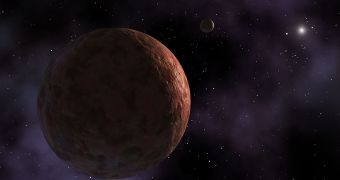The most recent apparition of one of the five dwarf planets known in the Solar System made possible an unprecedented examination of its physical features.
A report published in the November 22 issue of Nature depicts the achievements made by researchers concerning the planet's size, density and atmospheric properties.
The international research group lead by Jose Luis Ortiz from the Andalusian Institute of Astrophysics in Spain used seven telescopes, located around Chile and Brazil, in order to examine Makemake.
Scientists observed that the planet was not perfectly spherically shaped and that its size, previously estimated to be approximately two-thirds the size of Pluto, was actually 1,430km on one side and 1,500 on the other.
The density of the dwarf planet was stated to be close to that of Pluto, precisely of 1.7 grams per cubic centimeter.
However, the most interesting discovery was the one related to the characteristics of Makemake's atmosphere.
Experts were surprised to notice that while Makemake passed in front of Nomad, a very distant star, a phenomenon unlike the one Pluto registers in similar cases took place.
“As Makemake passed in front of the star and blocked it out, the star disappeared and reappeared very abruptly, rather than fading and brightening gradually,” declared Dr Ortiz, as cited by Phys.
“This means that the little dwarf planet has no significant atmosphere. It was thought that Makemake had a good chance of having developed an atmosphere - that it has no sign of one at all shows just how much we have yet to learn about these mysterious bodies,” he went on saying.
However little was understood due to Makemake's short appearance, researchers show themselves to be pleased.
“Finding out about Makemake's properties for the first time is a big step forward in our study of the select club of icy dwarf planets,” said Dr Ortiz.

 14 DAY TRIAL //
14 DAY TRIAL //